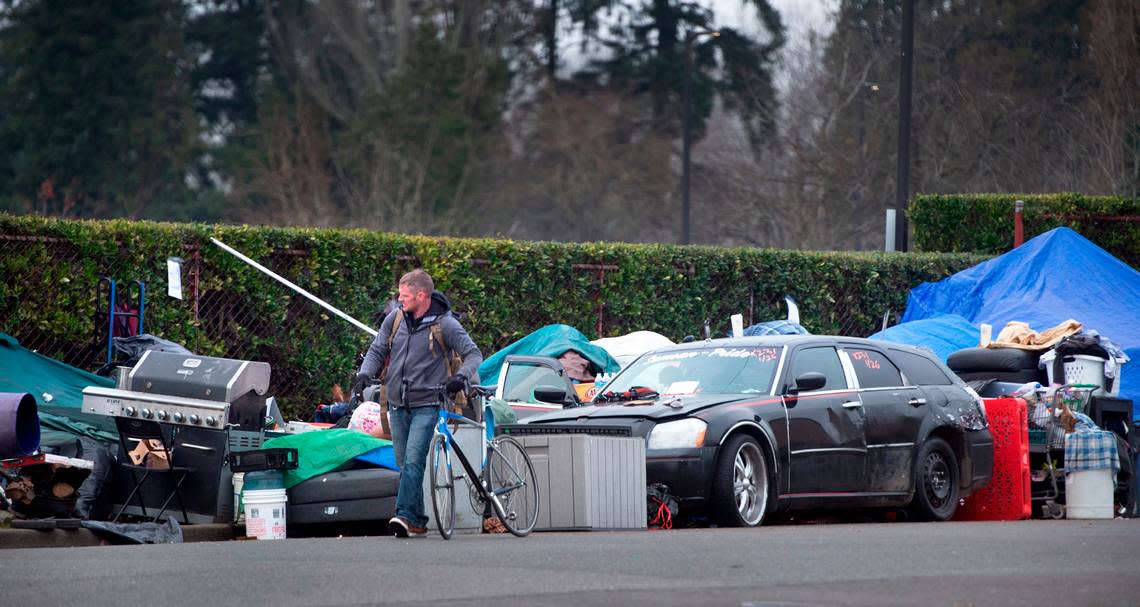‘It’s our job to do something.’ Tacoma council weighs encampment restriction ordinance

A proposed ordinance that would restrict where homeless encampments could set up might be a possible tool to address homelessness, several Tacoma City Council members agreed Tuesday, but some of them are concerned about enforcement of the ban and shelter space availability.
City Council member John Hines brought forward an ordinance that would prohibit unsanctioned homeless camps within 10 blocks of a temporary homeless shelter that is already established in Tacoma during the council’s study session Tuesday.
The proposed ordinance will receive its first reading next Tuesday and could be adopted as early as Sept. 27.
It would ban encampments near Tacoma Emergency Micro-Shelter Sites at 6th Avenue and Orchard Street; South 69th Street and Proctor Street; 60th Street and McKinley Avenue; the stability site at 1421 Puyallup Ave.; the mitigation sites at South 82nd Street and Pacific Avenue and 3561 Pacific Avenue, the RISE Center Emergency Stabilization Shelter, Altheimer Memorial Church of God in Christ, Bethlehem Baptist Church and Shiloh Baptist Church.
Hines, who represents District 1, said he wants to address encampments in Tacoma by providing shelter, and temporary sites have been considered a success.
“Providing shelter, providing temporary housing is a good thing, it’s not a detriment to the neighborhood,” he said during the study session. “It’s helping people move forward with their lives. Encampments, though, are a problem and are not helping anyone.”
A buffer that would prohibit camping and the storage of personal belongings on public property around temporary sites would allow the city to better address encampments before they become a health and safety issue, Hines said.
The city declared a public health emergency in 2017 to address the health and safety concerns caused by growing encampments.
City Manager Elizabeth Pauli said when encampments become a “heightened public health and safety issue,” they are removed with the city providing engagement and outreach. As the city does removals, it is offering open shelter beds, Pauli said.
The ordinance was co-sponsored by Sarah Rumbaugh, District 2, and Joe Bushnell, District 5.
“It’s our job to do something, and the reason why we’re supporting this is because not doing something is doing something as well,” Rumbaugh said.
Rumbaugh said she thinks the city clearing encampments is wrong and that it needs to offer another solution. She said the ordinance would ensure private property owners that allow for a temporary shelter on their site that it would be a safe space.
Mayor Victoria Woodards said she and Hines discussed the need for more shelter offerings ahead of a camping ban and the ability to have additional shelter sites. She said the council has begged the community to help set up additional shelter sites and has received pushback. She said the city created a successful model for the TEMS site.
“At some point, we have to have this tool in our toolbox, and now could absolutely be that time,” Woodards said about the proposed ordinance.
Council member Kiara Daniels, at-large, said she doesn’t agree the ordinance is the way forward. She questioned if the ban would just move encampments to outside of the barrier. She said encampment removal requires city funds and makes it harder to connect those in encampments with resources.
“We just move the problem and so we deal with the same thing over and over again,” Daniels said. “I’m trying to figure out how this solves that.”
Daniels said the city needs diversity in shelter options, including where shelters are located and a safe-parking space. She also raised concerns about the criminal penalty, a misdemeanor, and the additional funding or resources needed to pay the fine or for community court.
Council member Keith Blocker, District 3, said the ordinance could potentially be a good idea, but he raised concerns about the ability to enforce the ban when the city lacks resources for encampment cleanup. He asked where people would go in those buffer zone encampments. He also questioned the Police Department’s role in the ban as it tries to engage less with vulnerable populations.
Pauli said the Neighborhood and Community Services Department’s Homeless Engagement Alternatives Liaison (HEAL) would be adding additional staff, and the council could also add more positions in its budget.
Bushnell said the buffer would allow those that enter into shelter a chance to succeed. He said there are people who prey on the most vulnerable in the community and having a buffer would give those in shelters a couple blocks of reprieve.
Bushnell said businesses, residents and those trying to get help are suffering. He said the ordinance is not a perfect plan, that the city needs to get more people into shelter and provide them with more resources.
Hines said the way to end homelessness is to provide housing and shelter. The council has done that by setting up six Temporary Emergency Micro-Shelter Sites and mitigation sites and authorizing other shelter sites through partnerships with faith-based institutions.
“We’re going to continue to find partners to set up shelters,” he said. “We also have to continue to find ways to fund affordable housing.”
He said the city implemented a sales tax to fund affordable housing and is looking at rezoning to allow more density in the city. The city is also funding programs to support mental illness and addiction the community, he said.
Hines said he recognizes the long-term solutions needed to solve the root causes of homelessness do not move fast enough to address the impacts encampments have on neighborhoods and communities and the most vulnerable people.
